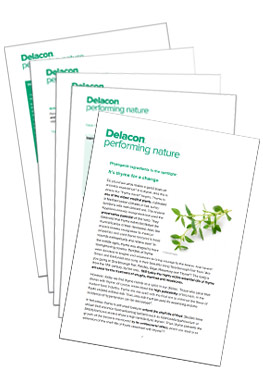Phytogenic ingredients in the spotlight: Eucalyptus - not only the favorite plant of the koalas (part 7)
After part 1, 2, 3, 4, 5 and 6 we end our Eucalyptus series with this part. Last but not least we want to introduce you to an effect of eucalyptus, which it is probably often associated with. We are talking about the mucolytic mode of action. Enjoy the last stop of our exciting journey into the world of one of the world's most famous medicinal plants.

Mucolytic benefits
It is the main component of eucalyptus oil, that does not only show the potential but is already well known as mucolytic and spasmolytic action on the respiratory tract, but also as proven clinical efficacy agent in inflammatory airway diseases. Again, its talk of 1,8-cineole. The versatile natural monoterpene is suggested in expansion to different mucolytics for its expectorant action in dyscrinemic mucus, as per the German Guideline for chronic obstructive pulmonary disease (COPD). Likewise, the guideline suggests that substances with anti-inflammatory and antioxidant effects can be utilized to diminish exacerbations in patients suffering from COPD. In vitro trials showed solid proof that 1,8-cineole does not only act as a simple mucolytic agent. Much more it is able to control inflammatory processes and mediator production of infection- or inflammation-induced mucus hypersecretion through its action as anti-inflammatory alterer (Juergens and Worth, 2014).
Further, it says that 1,8-cineole has appeared to significantly decrease worsening in patients with COPD. Up to date it is suggested that 1,8 cineole can be used as mucolytic and secretolytic drug. Besides, the multifunctional mechanisms of 1,8 cineole seem to control the cause of mucus production by a peripheral and systemic availability, comparable to inhaled medications, hence seeing it as possible additional therapy when counteracting COPD, asthma and sinusitis (Vogelmeier et al., 2018, Lykkesfeldt et al., 1996).
Not only effective in humans, but also in animals

Eucalyptus oil (EO) proofed its potential to be a promising candidate in the treatment of COPD. This was the conclusion of Wang (2017), who conducted a study on lipopolysaccharide (LPS) and Klebsiella pneumoniae - induced COPD in rats and treating them with the EO and Prednisone Acetate. Eucalyptus oil significantly reduced inflammatory cells in bronchoalveolar lavage fluid and blood, and decreased bronchiolitis, emphysematous changes and thickness of bronchioles. Due to pretreatment with EO, the production of proinflammatory cytokines TNF-α and IL-β in lung homogenate could be markly reduced. Moreover, the raised malondialdehyde level could also be decreased, whereas superoxide dismutase activity increased. Results suggest that the beneficial effect against LPS plus K. P-induced lung injury may result from inhibition of proinflammatory cytokines production and improvement of antioxidant status.
A study of Worth (2009) confirmed beneficial characteristics of 1,8 Cineol, when nearly 250 patients with confirmed asthmatic disorders where administered 200mg of cineole, or a placebo, three times per day as additional therapy over 6 months. The outcome clearly showed improvements in tested parameters (lung function, asthma symptoms, life quality) due to the cineole treatment of patients, compared to the placebo group. Thus, concluding that concomitant therapy with cineole may result in evident enhancement of lung function and health condition while also decrease dyspnea in patients suffering from asthma.
At Delacon...
...we have been using eucalyptus and its versatile beneficial effects for quite a long time and it is present in various of our products. Besides many other valuable plants and their bioactive substances, eucalyptus clearly has a strong position in our phytogenic universe. Its antimicrobial action, but also its expectorant, secretolytic and spasmolytic effects are of great importance to us, when facing the many challenging aspects of animal husbandry and animal production.
Do you want the entire article as PDF including all references?

You are only one click away.
References upon request.

Elisabeth Rohrer
After her study in agriculture sciences at the university of natural resources and life sciences in Vienna, Elisabeth joined the Delacon team in December 2013 as Technical Communications Manager - a position, she always exerted with pleasure. Since 2021, her task areas have been extended and thus, she is also supporting colleagues in writing offside the technical focus as Content Manager. Elisabeth describes herself as a great animal and nature lover and prefers to spend her free time high up in the mountains with her little family, away from the hustle and bustle.











Excellent and interesting article